Abstract
The occurrence of chronic diarrhoea was evaluated in 173 consecutive patients previously treated with radiation for gynaecological cancer. A survey of gastrointestinal symptoms showed a high frequency of diarrhoea; 13% of the patients had 21 or more bowel movements a week and 3% had 28 or more. Significantly more patients who had a cholecystectomy were in the group with diarrhoea (chi 2 = 6.26; p less than 0.02). Twenty patients with chronic or intermittent diarrhoea were subject to extended gastrointestinal investigation. Bile acid malabsorption was evaluated by the 75Selenahomocholic acid-taurine test (SeHCAT). Bile acid malabsorption was found in 13 (65%) of the 20 patients further investigated, of whom seven had extremely low whole body retention values, which is consistent with severe malabsorption. The results suggest that bile acid malabsorption is a common cause of diarrhoea after radiation treatment for gynaecological cancer. Bacterial contamination was diagnosed in nine patients (45%) by the [14C]-D-xylose breath test or by the cholyl-[14C]-glycine breath test in combination with a normal test for bile acid malabsorption. All patients with vitamin B-12 deficiency, who were tested for bile acid malabsorption, had low retention times for the SeHCAT (p = 0.05). A significant decline in the frequency of diarrhoea was found after treatment with antibiotics or bile acid sequestrants, or both, in combination with a reduced fat diet.
Full text
PDF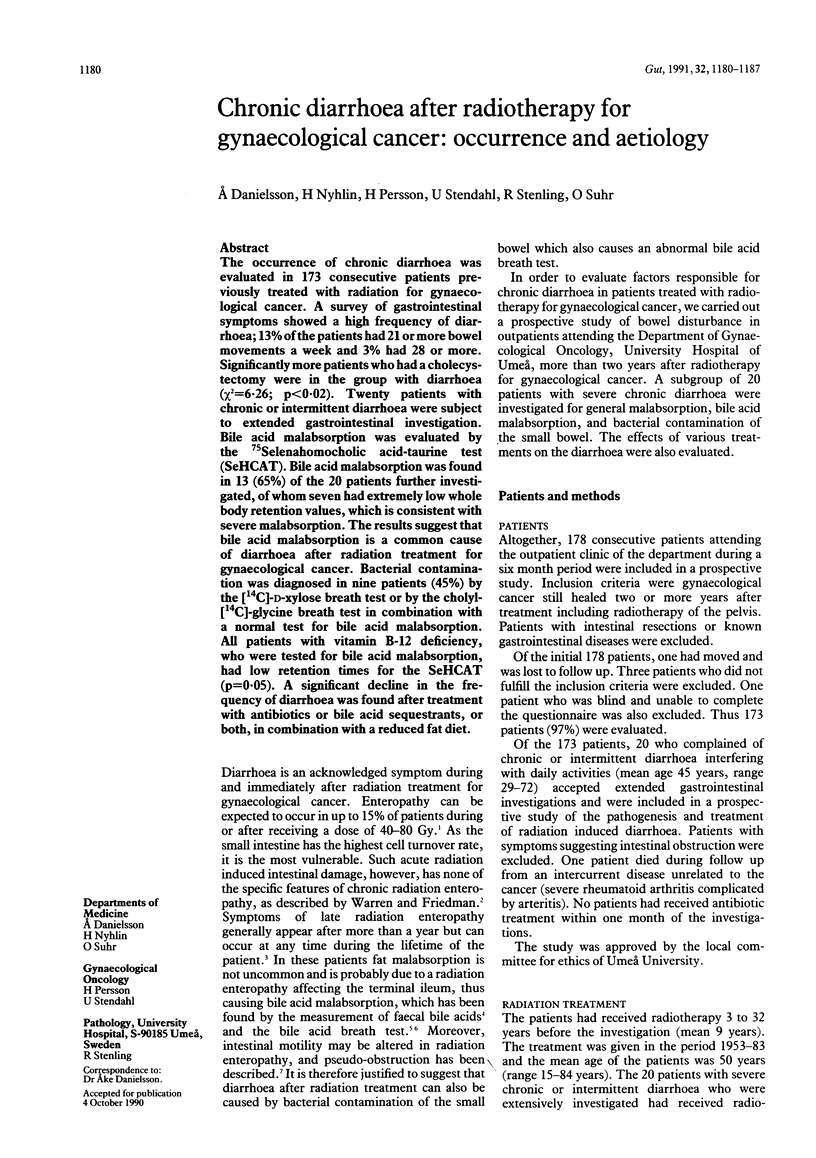
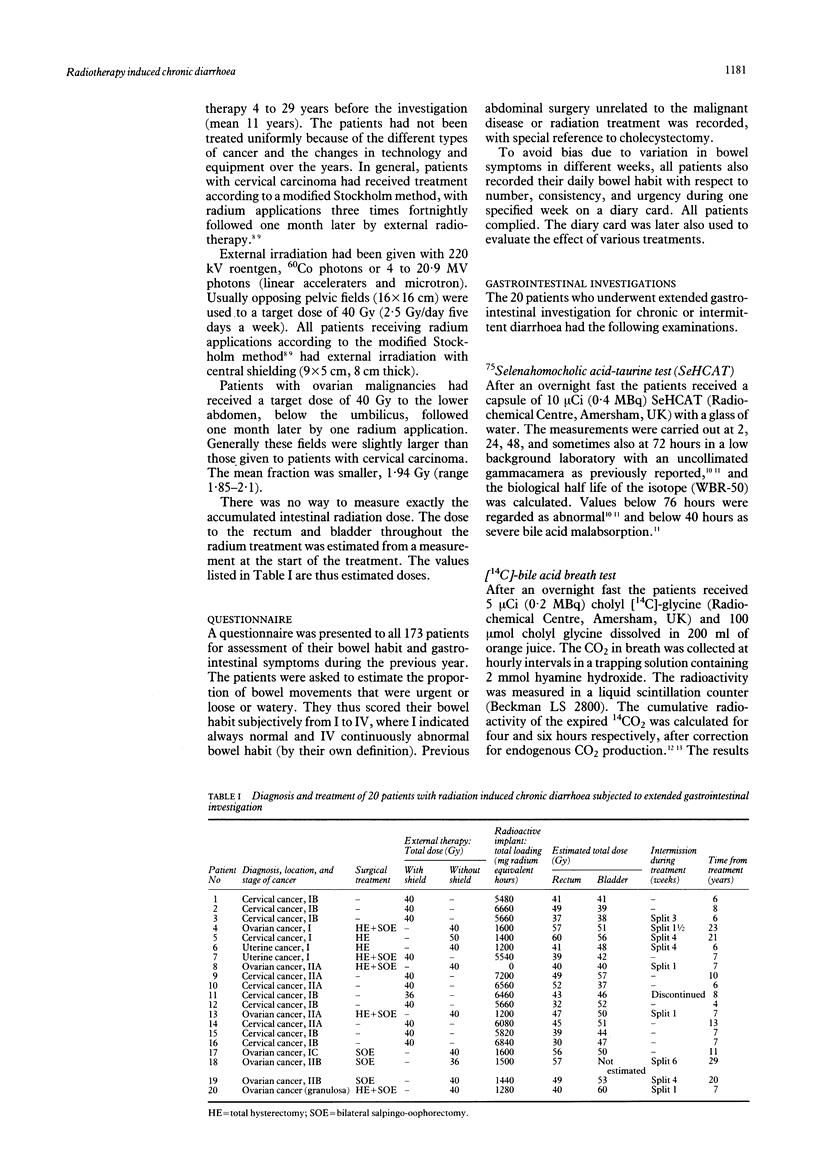
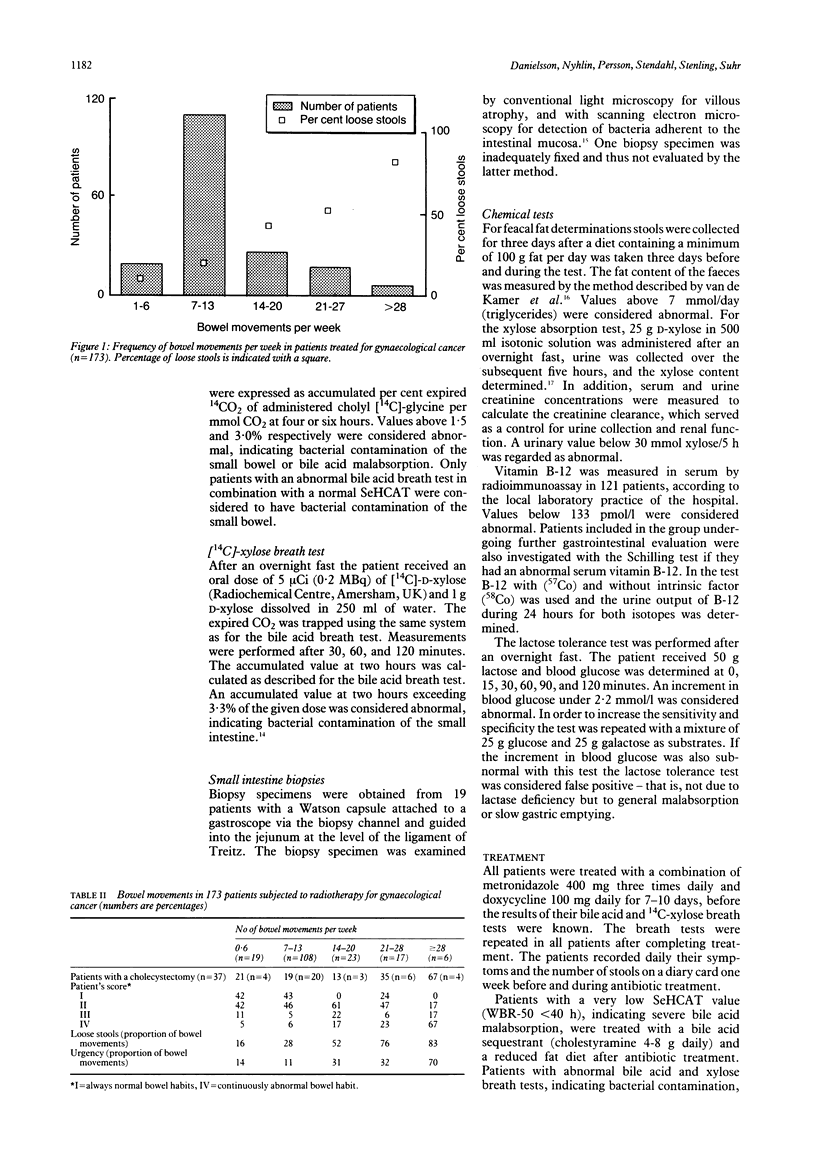

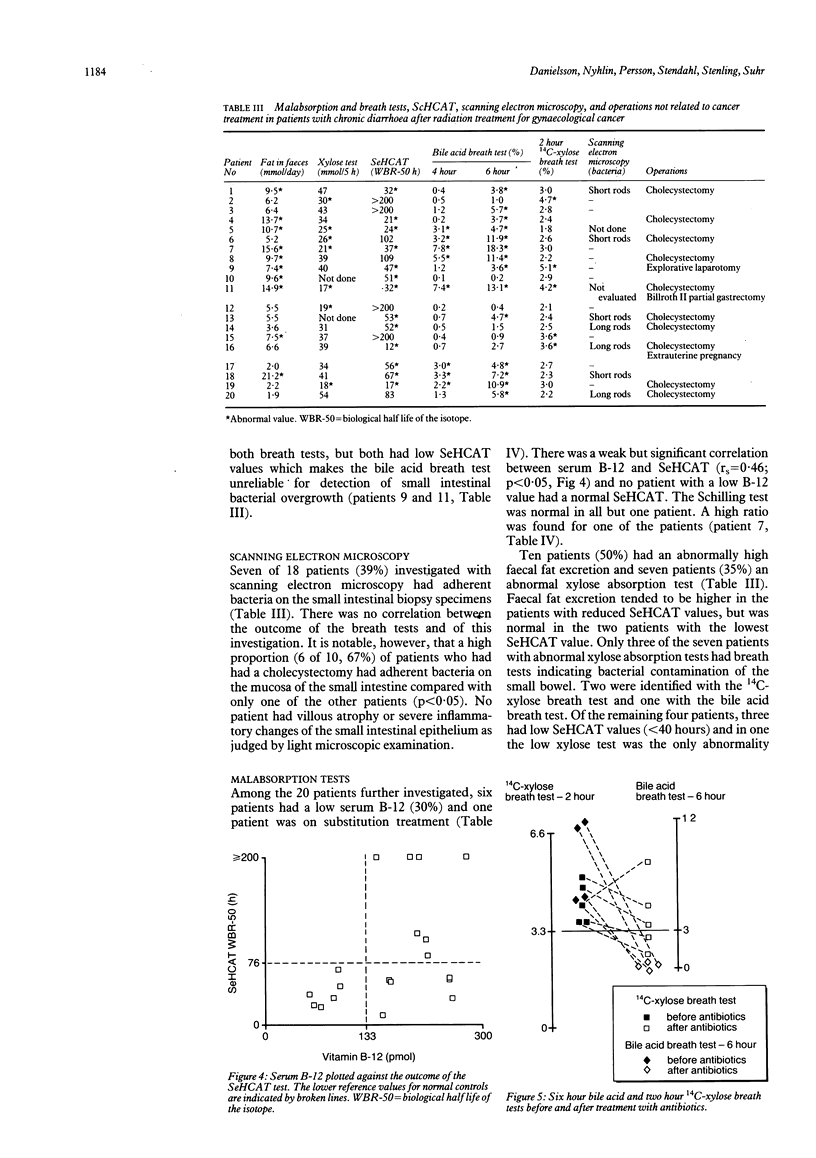
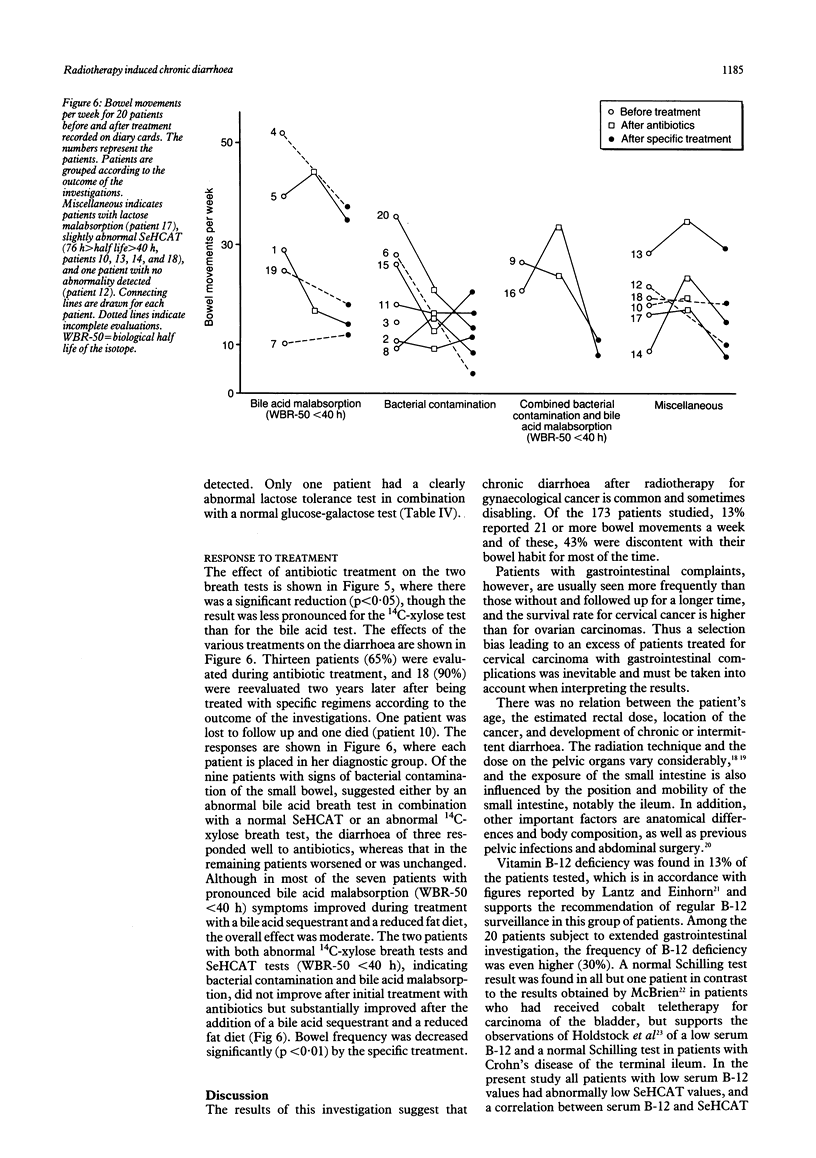
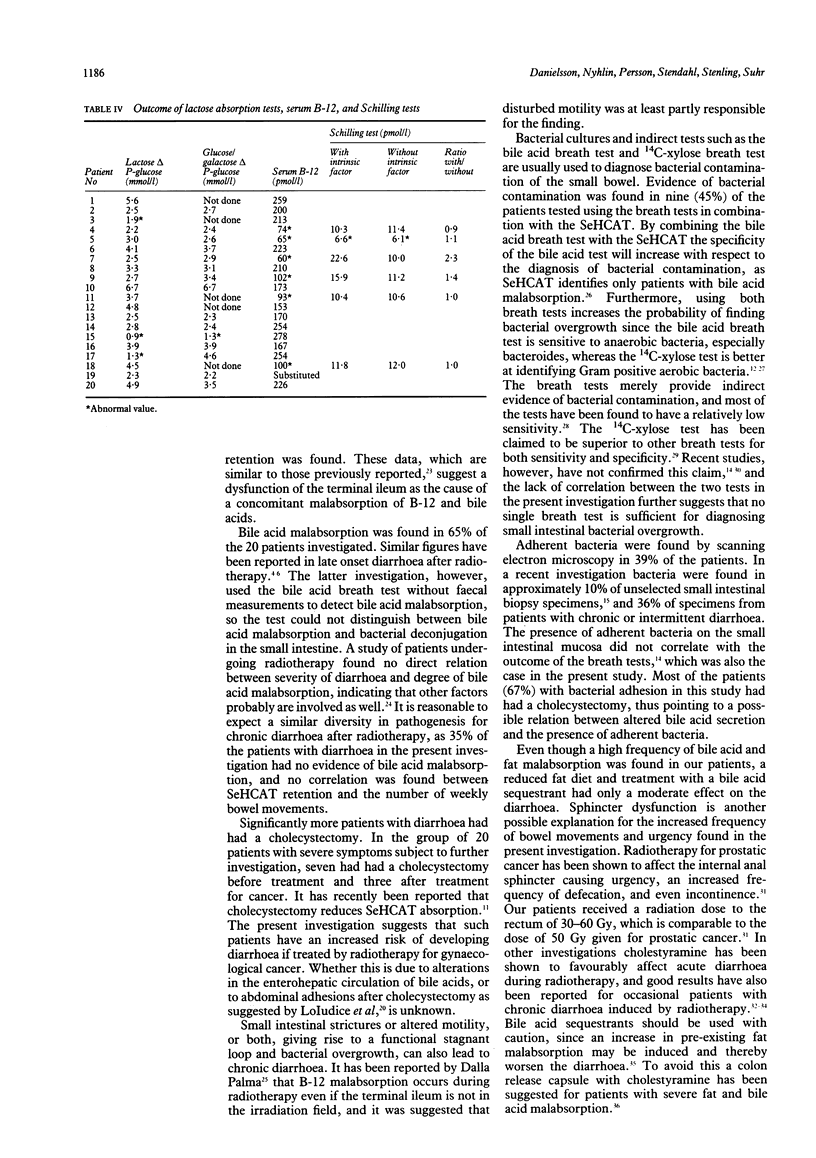
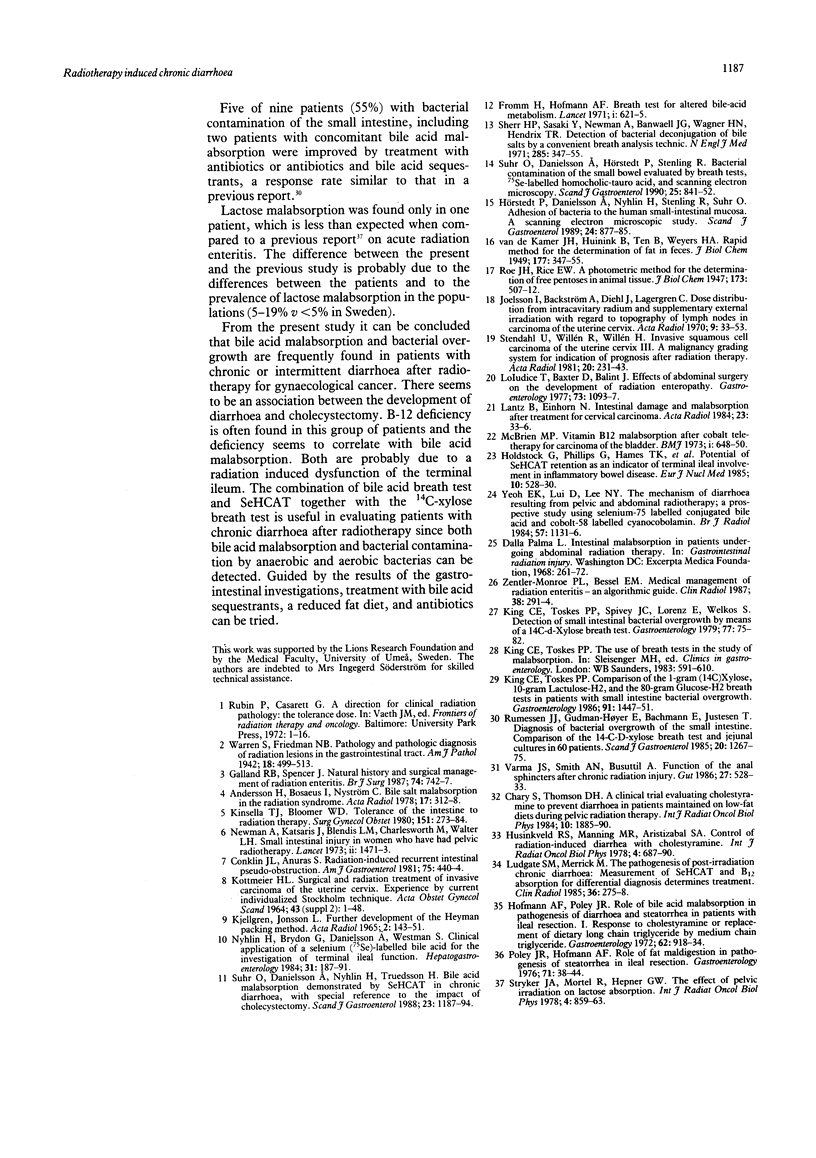
Selected References
These references are in PubMed. This may not be the complete list of references from this article.
- Andersson H., Bosaeus I., Nyström C. Bile salt malabsorption in the radiation syndrome. Acta Radiol Oncol Radiat Phys Biol. 1978;17(4):312–318. doi: 10.3109/02841867809127934. [DOI] [PubMed] [Google Scholar]
- Chary S., Thomson D. H. A clinical trial evaluating cholestyramine to prevent diarrhea in patients maintained on low-fat diets during pelvic radiation therapy. Int J Radiat Oncol Biol Phys. 1984 Oct;10(10):1885–1890. doi: 10.1016/0360-3016(84)90267-0. [DOI] [PubMed] [Google Scholar]
- Conklin J. L., Anuras S. Radiation-induced recurrent intestinal pseudo-obstruction. Am J Gastroenterol. 1981 Jun;75(6):440–444. [PubMed] [Google Scholar]
- Feigin R. D. NBT test in the diagnosis of febrile patients. N Engl J Med. 1971 Aug 5;285(6):347–348. doi: 10.1056/NEJM197108052850611. [DOI] [PubMed] [Google Scholar]
- Fromm H., Hofmann A. F. Breath test for altered bile-acid metabolism. Lancet. 1971 Sep 18;2(7725):621–625. doi: 10.1016/s0140-6736(71)80068-5. [DOI] [PubMed] [Google Scholar]
- Galland R. B., Spencer J. Natural history and surgical management of radiation enteritis. Br J Surg. 1987 Aug;74(8):742–747. doi: 10.1002/bjs.1800740833. [DOI] [PubMed] [Google Scholar]
- Heusinkveld R. S., Manning M. R., Aristizabal S. A. Control of radiation-induced diarrhea with cholestyramine. Int J Radiat Oncol Biol Phys. 1978 Jul-Aug;4(7-8):687–690. doi: 10.1016/0360-3016(78)90194-3. [DOI] [PubMed] [Google Scholar]
- Hofmann A. F., Poley J. R. Role of bile acid malabsorption in pathogenesis of diarrhea and steatorrhea in patients with ileal resection. I. Response to cholestyramine or replacement of dietary long chain triglyceride by medium chain triglyceride. Gastroenterology. 1972 May;62(5):918–934. [PubMed] [Google Scholar]
- Holdstock G., Phillips G., Hames T. K., Condon B. R., Fleming J. S., Smith C. L., Ackery D. M. Potential of SeHCAT retention as an indicator of terminal ileal involvement in inflammatory bowel disease. Eur J Nucl Med. 1985;10(11-12):528–530. doi: 10.1007/BF00252746. [DOI] [PubMed] [Google Scholar]
- Hörstedt P., Danielsson A., Nyhlin H., Stenling R., Suhr O. Adhesion of bacteria to the human small-intestinal mucosa. A scanning electron microscopic study. Scand J Gastroenterol. 1989 Sep;24(7):877–885. doi: 10.3109/00365528909089229. [DOI] [PubMed] [Google Scholar]
- Joelsson I., Bäckström A., Diehl J., Lagergren C. Dose distribution from intracavitary radium and supplementary external irradiation with regard to topography of lymph nodes in carcinoma of the uterine cervix. Acta Radiol Ther Phys Biol. 1970 Feb;9(1):33–54. doi: 10.3109/02841867009129089. [DOI] [PubMed] [Google Scholar]
- KJELLGREN O., JONSSON L. FURTHER DEVELOPMENT OF THE HEYMAN RADIUM PACKING METHOD. Acta Radiol Ther Phys Biol. 1965 Apr;3:143–151. doi: 10.3109/02841866509133088. [DOI] [PubMed] [Google Scholar]
- KOTTMEIER H. L. SURGICAL AND RADIATION TREATMENT OF CARCINOMA OF THE UTERINE CERVIX. EXPERIENCE BY THE CURRENT INDIVIDUALIZED STOCKHOLM TECHNIQUE. Acta Obstet Gynecol Scand. 1964;43:SUPPL2–SUPPL248. doi: 10.3109/00016346409156823. [DOI] [PubMed] [Google Scholar]
- King C. E., Toskes P. P. Comparison of the 1-gram [14C]xylose, 10-gram lactulose-H2, and 80-gram glucose-H2 breath tests in patients with small intestine bacterial overgrowth. Gastroenterology. 1986 Dec;91(6):1447–1451. doi: 10.1016/0016-5085(86)90199-x. [DOI] [PubMed] [Google Scholar]
- King C. E., Toskes P. P., Spivey J. C., Lorenz E., Welkos S. Detection of small intestine bacterial overgrowth by means of a 14C-D-xylose breath test. Gastroenterology. 1979 Jul;77(1):75–82. [PubMed] [Google Scholar]
- Kinsella T. J., Bloomer W. D. Tolerance of the intestine to radiation therapy. Surg Gynecol Obstet. 1980 Aug;151(2):273–284. [PubMed] [Google Scholar]
- Lantz B., Einhorn N. Intestinal damage and malabsorption after treatment for cervical carcinoma. Acta Radiol Oncol. 1984;23(1):33–36. doi: 10.3109/02841868409135982. [DOI] [PubMed] [Google Scholar]
- LoIudice T., Baxter D., Balint J. Effects of abdominal surgery on the development of radiation enteropathy. Gastroenterology. 1977 Nov;73(5):1093–1097. [PubMed] [Google Scholar]
- Ludgate S. M., Merrick M. V. The pathogenesis of post-irradiation chronic diarrhoea: measurement of SeHCAT and B12 absorption for differential diagnosis determines treatment. Clin Radiol. 1985 May;36(3):275–278. doi: 10.1016/s0009-9260(85)80059-3. [DOI] [PubMed] [Google Scholar]
- McBrien M. P. Vitamin B 12 malabsorption after cobalt teletherapy for carcinoma of the bladder. Br Med J. 1973 Mar 17;1(5854):648–650. doi: 10.1136/bmj.1.5854.648. [DOI] [PMC free article] [PubMed] [Google Scholar]
- Newman A., Katsaris J., Blendis L. M., Charlesworth M., Walter L. H. Small-intestinal injury in women who have had pelvic radiotherapy. Lancet. 1973 Dec 29;2(7844):1471–1473. doi: 10.1016/s0140-6736(73)92732-3. [DOI] [PubMed] [Google Scholar]
- Nyhlin H., Brydon G., Danielsson A., Westman S. Clinical application of a selenium (75Se)-labelled bile acid for the investigation of terminal ileal function. Hepatogastroenterology. 1984 Aug;31(4):187–191. [PubMed] [Google Scholar]
- Poley J. R., Hofmann A. F. Role of fat maldigestion in pathogenesis of steatorrhea in ileal resection. Fat digestion after two sequential test meals with and without cholestyramine. Gastroenterology. 1976 Jul;71(1):38–44. [PubMed] [Google Scholar]
- Rumessen J. J., Gudmand-Høyer E., Bachmann E., Justesen T. Diagnosis of bacterial overgrowth of the small intestine. Comparison of the 14C-D-xylose breath test and jejunal cultures in 60 patients. Scand J Gastroenterol. 1985 Dec;20(10):1267–1275. doi: 10.3109/00365528509089288. [DOI] [PubMed] [Google Scholar]
- Stendahl U., Eklund G., Willén H., Willén R. Invasive squamous cell carcinoma of the uterine cervix. III. A malignancy grading system for indication of prognosis after radiation therapy. Acta Radiol Oncol. 1981;20(4):231–243. doi: 10.3109/02841868109130201. [DOI] [PubMed] [Google Scholar]
- Stryker J. A., Mortel R., Hepner G. W. The effect of pelvic irradiation on lactose absorption. Int J Radiat Oncol Biol Phys. 1978 Sep-Oct;4(9-10):859–863. doi: 10.1016/0360-3016(78)90048-2. [DOI] [PubMed] [Google Scholar]
- Suhr O., Danielsson A., Hörstedt P., Stenling R. Bacterial contamination of the small bowel evaluated by breath tests, 75Se-labelled homocholic-tauro acid, and scanning electron microscopy. Scand J Gastroenterol. 1990 Aug;25(8):841–852. doi: 10.3109/00365529008999224. [DOI] [PubMed] [Google Scholar]
- Suhr O., Danielsson A., Nyhlin H., Truedsson H. Bile acid malabsorption demonstrated by SeHCAT in chronic diarrhoea, with special reference to the impact of cholecystectomy. Scand J Gastroenterol. 1988 Dec;23(10):1187–1194. doi: 10.3109/00365528809090189. [DOI] [PubMed] [Google Scholar]
- Varma J. S., Smith A. N., Busuttil A. Function of the anal sphincters after chronic radiation injury. Gut. 1986 May;27(5):528–533. doi: 10.1136/gut.27.5.528. [DOI] [PMC free article] [PubMed] [Google Scholar]
- Warren S., Friedman N. B. Pathology and Pathologic Diagnosis of Radiation Lesions in the Gastro-Intestinal Tract. Am J Pathol. 1942 May;18(3):499–513. [PMC free article] [PubMed] [Google Scholar]
- Yeoh E. K., Lui D., Lee N. Y. The mechanism of diarrhoea resulting from pelvic and abdominal radiotherapy; a prospective study using selenium-75 labelled conjugated bile acid and cobalt-58 labelled cyanocobalamin. Br J Radiol. 1984 Dec;57(684):1131–1136. doi: 10.1259/0007-1285-57-684-1131. [DOI] [PubMed] [Google Scholar]
- Zentler-Munro P. L., Bessell E. M. Medical management of radiation enteritis--an algorithmic guide. Clin Radiol. 1987 May;38(3):291–294. doi: 10.1016/s0009-9260(87)80074-0. [DOI] [PubMed] [Google Scholar]


